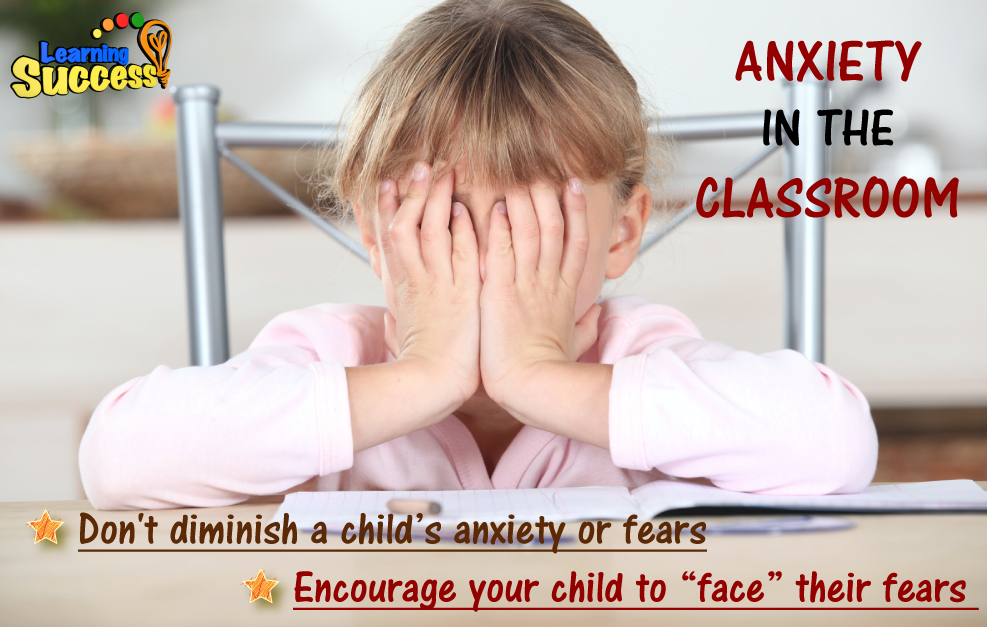
I always look forward to the first day of the new school year. As a teacher, I am always eager to begin the year and meet all of my new students.
Usually, I would have a few timid students hiding behind their parents not wanting to engage their peers or explore their new classroom.
Sometimes I have that one or two with social or separation anxiety.
Anxiety manifests in various forms. Parents often tell me they do not realize that children can have persistent anxiety and diminish it as a more adult diagnosis.
In my experience, children do get short bursts of anxiety which may be due to stress at home or school. It can be from, say, watching a scary movie or the death of a loved one.
Below are four types of chronic anxiety evident in early childhood:
Generalized Anxiety Disorder
Generalized anxiety disorder (GAD) is a constant, excessive and uncontrollable fear throughout the day that includes worrying about grades, extracurricular activities (such as sports and music lessons) or the weather. As a teacher and parent, you may see GAD manifest in a child in the form of a perfectionist.
Separation Anxiety
Separation anxiety is common with children of all ages. It manifests when the child’s caregiver is separated from the child for a length of time. As the child gets older, they may develop fear that something catastrophic will happen to their caregivers. Typically, separation anxiety will dissipate as the child becomes more comfortable with their environment and their secondary caregiver.
Post-traumatic Stress Disorder
We often hear PTSD being associated with our men and women in service. But children also experience PTSD, especially after observing or suffering a traumatic event, like a house fire or natural disaster. They can experience flashbacks, insomnia, anxiety, or re-enact the event while playing with their peers.
Phobias
Many children experience phobias or the fear of something. Children may fear insects, sleeping alone in the dark, flying, heights, social settings, etc. But a phobia is intense, causes significant anxiety and interrupts their ability to function properly in school and home.

Step back, assess, and review
As teachers and parents, we are not equipped to diagnosis or treat these conditions. But recognizing the symptoms and facilitating treatment impacts our children’s wellbeing.
We can be a support system to our child. Take a step back and assess your children’s sleep routine and eating habits to ensure their basic needs are met to guarantee a healthy emotional state.
If phobias or anxiety persists, review what your child watches on TV or what type of role-playing they engage with their peers or older children.
You can assist an anxious child with the following:
- Maintain and be consistent with a routine in the home and school.
- Be in tune with your child’s feelings.
- Prepare a child for changes to minimize any surprise or anxiety.
- Check your own feelings, behaviors and how they manifest.
- Don’t remove all anxiety triggers.
- Provide positive re-enforcement and do not diminish a child’s anxiety or fears.
- Allow a child to bring a small yet significant item from home as a link to their caregivers.
Get to the root of the problem
I remember an encounter with a student who had persistent anxiety throughout the first semester of school.
Every morning, when the child’s mother dropped the child off to school, it was the same scene played out repetitively — crying, clinging to her mother, and eventually sitting at her desk, head down and crying.
The parents and I tried several things, such as having dad drop the child off at school instead of mom and allowing the child to video chat with her mom throughout the day.
Very little worked with the child and the parents were desperate to understand and “fix” their daughter’s anxiety.
We found out, through play therapy and observation, that a neighbor boy had been bullying the child and convinced her that her parents were going to abandon her.
Once the boy apologized and conveyed he had lied, the child slowly began to thrive educationally and socially in the classroom.
It was a frustrating process, but getting down to the root of her anxiety helped us deal with the problem.
That is what you need to do if you detect such signs in your child.
Key Takeaways:
Anxiety Over School
Children can also develop extreme anxiety over schoolwork. This happens because they have made up their minds that they are not intelligent. Their biggest fear is that you will find out. Maybe you won't love them if you find out (they think). Of
Of course, this rationalization isn't true, but they make it true in their own minds. A child fearing the loss of love is an extreme fear. It is biological and a very deep level. Their biology actually equates loss of love to death. At a deep level their emotions are telling them they won't survive if you stop loving them.
This fear builds up over time when they have struggled with homework.
That's why, if the anxiety is due to struggling academically, it is important to use a program that not only helps them with developing their learning skills, but also develops confidence along the way. Confidence eliminates anxiety. Building confidence and improving learning skills is at the core of the Learning Success System.
.
Sometimes the root of a child's anxieties is difficult to understand.
Helping them through these anxieties using good parenting skills, professional help if needed, and modern teaching techniques can make all the difference. Helping them become a well adjusted child who is always ready to take on new challenges.
Do You Need help with a Learning Difficulty?
Our simple online analysis will help you get to the core of the problem and find the right solution for you.
Understanding how to help someone with a learning difficulty starts with understanding which micro-skills are affected. When you learn which of the micro-skills is the problem, you will then be on your way to solving it.
You'll also learn how to:
- Build confidence
- Enhance Learning ability
- Eliminate avoidance
- Build grit
You can get this analysis for free by filling out this simple form. This will help you get to the bottom of a learning difficulty and provide you with a solution. If you are ready to put this problem behind you click the button below and fill out the form.










